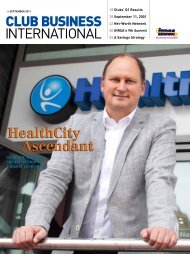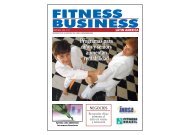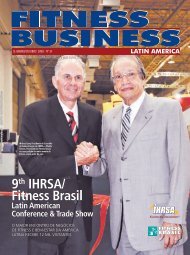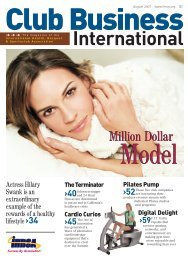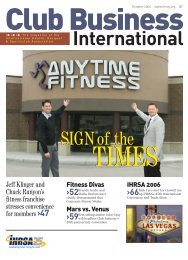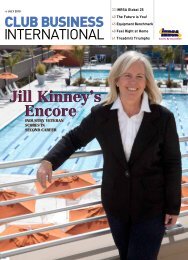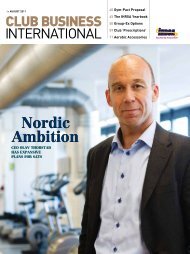Augie In Action! Augie In Action! - Ihrsa
Augie In Action! Augie In Action! - Ihrsa
Augie In Action! Augie In Action! - Ihrsa
You also want an ePaper? Increase the reach of your titles
YUMPU automatically turns print PDFs into web optimized ePapers that Google loves.
| News & Know How | News<br />
<strong>In</strong> U.K., a<br />
Changing<br />
of the Guard<br />
FIA chairman calls for creation<br />
of National Wellness Service<br />
> <strong>In</strong> an unprecedented move, Fred Turok,<br />
the chairman of the Fitness <strong>In</strong>dustry<br />
Association (FIA), a nonprofit trade<br />
organization based in the U.K. that,<br />
among other things, works to promote<br />
physical activity, has put pressure on the<br />
government to change its approach to<br />
healthcare. He’s called for the formation<br />
of a National Wellness Service, which<br />
would be similar to the National Health<br />
Service (NHS), Britain’s publicly funded<br />
healthcare system, but would focus less<br />
on treating the sick and concentrate more<br />
on fostering wellness and preventing the<br />
onset of illness.<br />
At the 2007 FIA Annual <strong>In</strong>dustry Summit<br />
in November, Turok, recognizing the everescalating<br />
cost of healthcare, appealed to<br />
government leaders to direct resources<br />
toward the creation<br />
of this new<br />
service. Such a<br />
move, he argued,<br />
would “cost a<br />
fraction of what<br />
we currently<br />
spend on treating<br />
the lifestyle-related<br />
diseases we<br />
currently could<br />
prevent, but fail<br />
to do so.”<br />
Fred<br />
Turok<br />
Pledging up to $1.1 billion in donations<br />
from the fitness industry to initiate what<br />
he termed an “Olympic Legacy,” Turok<br />
recommended that the government make<br />
the most of the nation’s underused fitness<br />
resources, namely “6,000 gyms [located]<br />
no more than 20 minutes from almost<br />
90% of the population, and almost 25,000<br />
trained fitness professionals.” (London<br />
has been selected as the site for the 2012<br />
Olympic and Paralympic Games.)<br />
Prior to joining FIA, Turok had founded<br />
and developed LA Fitness, one of the<br />
U.K.’s leading club chains; it currently<br />
has some 88 facilities and more than<br />
250,000 members. —|<br />
40 Club Business <strong>In</strong>ternational | MARCH 2008 | www.ihrsa.org<br />
Personal Training<br />
Testing Trainer Effectiveness<br />
By Dawn Allcot<br />
The conventional wisdom is that three key factors contribute to a<br />
personal trainer’s success—education/training; level of experience;<br />
and interpersonal skills.<br />
Cedric Bryant, Ph.D., the chief science officer for the American Council on<br />
Exercise (ACE), is concerned that many club owners don’t give enough<br />
consideration to the third area. “It’s called personal training for a reason,” he<br />
asserts. “The trainer and the client must establish a good personal connection.”<br />
So, how do you ensure that your trainers are delivering on the all-important<br />
“personal” portion of their jobs?<br />
Customer-service surveys are one way to determine<br />
whether or not a trainer communicates clearly,<br />
motivates clients without intimidating them, and<br />
remains attentive during training sessions.<br />
Bill Sonnemaker, the CEO of Catalyst Fitness, in<br />
Kennesaw, Georgia, takes written assessments a<br />
step further. His trainers complete self-evaluation<br />
forms, providing in-depth responses to questions<br />
about client retention, participation, and success, as<br />
well as their own goals and efforts.<br />
If you’re looking for solid numbers to evaluate a<br />
trainer’s job performance, review client retention rates, Personal touch<br />
new customers, hours worked, total revenue brought<br />
in, and total clients. “If members are attending<br />
regularly, not missing sessions, and seem to be getting a good experience, that would<br />
indicate quality performance on the part of the trainer,” says Bryant.<br />
Professional certifications provide another measurable benchmark. Sonnemaker<br />
requires that his trainers be certified through the National Academy of Sports<br />
Medicine (NASM), one of the many agencies that meets IHRSA’s recommendation<br />
of accreditation by a third-party accrediting body. “I cannot impress upon you the<br />
feeling of relief that comes from knowing that all of our trainers are playing on the<br />
same field,” says Sonnemaker.<br />
Certification goes hand-in-hand with ongoing education; experts recommend<br />
that trainers receive a minimum of 10 hours per year of continuing education, in<br />
the form of live workshops, seminars/conferences, distance-learning courses,<br />
or written coursework.<br />
Club owners may wish to consider providing tuition-assistance or paid time off<br />
to encourage continuing education. “Personal training generates a significant<br />
amount of revenue for most club operations,” Bryant points out. “It makes sense<br />
for the club owner to invest in the people responsible for generating it.”<br />
Bryant also suggests hosting a seminar or workshop onsite at the club. “It<br />
makes it convenient for trainers to continue their education, but it also brings some<br />
excitement to the club!”<br />
Written evaluations and metrics assessments give club owners a yardstick by<br />
which to measure trainers’ effectiveness, but nothing beats active management,<br />
according to Bryant. “Walk the floor and observe your staff. When they understand<br />
that you’re engaged in day-to-day operations, it will dramatically affect how your<br />
staff approaches the job.” —|<br />
– Dawn Allcot, dawnallcot@gmail.com



